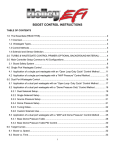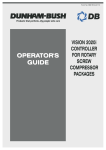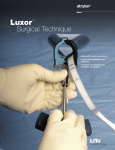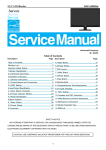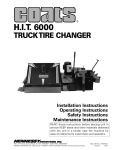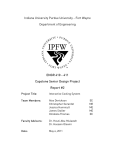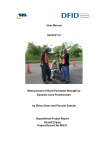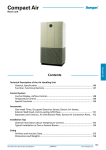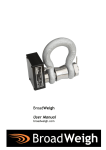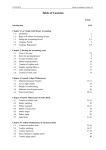Download Dunham-Bush R407C WCPS-B Series Troubleshooting guide
Transcript
Form No: MM0214A / MM0215A ® Products That Perform . . .By People Who Care Water- Cooled Single Package Air-Conditioner with Scoll Compressors R22 / R407C 50 / 60 Hz WCPS-B Series TABLE OF CONTENTS MANUAL INDEX PAGE 1.0 INTRODUCTION................................................................................................................................................................... 3 2.0 GENERAL INFORMATION 2.1 SAMPLE NOMENCLATURE ................................................................................................................................................. 4 2.2 2.3 2.4 RECEIVING, INSPECTION AND PACKAGING........................................................................................................................ 4 RIGGING AND UNCRATING................................................................................................................................................. 5 LIMITATIONS...................................................................................................................................................................... 5 3.0 INSTALLATION 3.1 FOUNDATION ..................................................................................................................................................................... 6 ( i.) Provide A Separate Floating Plinth.................................................................................................................................. 6 ( ii.) Place The Unit On A Minimum 2½” Thick Cork Sheet ........................................................................................................ 7 ( iii.) Support The Complete Unit On Spring Isolators. Request Factory To Provide Correct Spring Isolators And Mounting Brackets At Base Units............................................................................................ 7 3.2 LOCATIONS ....................................................................................................................................................................... 7 3.3 CLEARANCE...................................................................................................................................................................... 7 Figure 3.3A: For Units With Single Side Return Air, WCPS 68B To 570B ...................................................................................... 8 Figure 3.3B: For Units With Single Side Return Air, WCPS 640B To 1520B ................................................................................... 9 3.4 UNPACKING AND UNCRATING.......................................................................................................................................... 10 3.5 BLOWER SECTION ........................................................................................................................................................... 10 3.5.1 Discharge Pattern .................................................................................................................................................... 10 3.5.2 Duct Connections .................................................................................................................................................... 10 Figure 3.5.1: Blower Discharge Pattern .......................................................................................................................... 11 Figure 3.5.2: Suggested Method For Connecting Supply Duct To Twin Blower Unit .............................................................. 12 3.6 EVAPORATOR SECTION ................................................................................................................................................... 12 Figure 3.6: Condensate Drain Trap ....................................................................................................................................... 12 3.7 CONDENSER SECTION ..................................................................................................................................................... 13 3.8 COOLING TOWER ............................................................................................................................................................ 13 Figure 3.8A: Cooling Tower Water Piping Schematic ............................................................................................................... 14 Figure 3.8B: Unit Control On Water Flow ............................................................................................................................... 14 Figure 3.8C: Alternate Unit Control On Water Flow .................................................................................................................. 14 4.0 OPERATION 4.1 4.2 4.3 SYSTEMS CAPACITY........................................................................................................................................................ 15 SYSTEM WATER FLOW .................................................................................................................................................... 15 TEMPERATURE CONTROL ................................................................................................................................................ 15 4.4 4.5 TEMPERATURE SETTING ................................................................................................................................................. 16 PHASE ROTATION ............................................................................................................................................................ 16 4.6 4.7 4.8 CYCLE LIMIT RATE........................................................................................................................................................... 16 HOT GAS BYPASS............................................................................................................................................................ 16 REFRIGERANT CIRCUIT AND COMPONENTS ..................................................................................................................... 17 Figure 4.8: Typical Refrigerant Piping And Components ........................................................................................................... 17 4.9 TYPICAL OPERATING SEQUENCE FLOW CHART............................................................................................................... 18 4.10 START UP CHECKLIST ..................................................................................................................................................... 19 4.11 TYPICAL WIRING SCHEMATIC WITHOUT STARTER ........................................................................................................... 20 4.12 TYPICAL WIRING SCHEMATIC WITH DOL .......................................................................................................................... 20 4.13 TYPICAL WIRING SCHEMATIC WITH AUTOTRANS ............................................................................................................. 21 5.0 MAINTENANCE 5.1 GENERAL ........................................................................................................................................................................ 22 5.2 SCHEDULE OF INSPECTION AND MAINTENANCE.............................................................................................................. 22 5.2.1 Monthly Inspection And Maintenance ........................................................................................................................ 22 5.2.2 Three Monthly Inspection And Maintenance ............................................................................................................... 22 5.2.3 Annual Inspection And Maintenance.......................................................................................................................... 22 5.3 CONDENSER MAINTENANCE............................................................................................................................................ 23 5.3.1 General .................................................................................................................................................................... 23 5.3.2 Condenser Cleaning................................................................................................................................................. 23 5.3.3 Tube Replacement.................................................................................................................................................... 24 5.4 5.5 WATER TREATMENT ........................................................................................................................................................ 24 TIGHTENING OF BEARING SET SCREW ............................................................................................................................ 24 5.6 5.7 PULLEY ALIGNMENT........................................................................................................................................................ 25 BELT TENSION INSPECTION GUIDE.................................................................................................................................. 25 5.8 5.9 TROUBLE-SHOOTING CHART ........................................................................................................................................... 27 SAMPLE LOG SHEET ........................................................................................................................................................ 30 1.0 INTRODUCTION This equipment is factory manufactured and tested water-cooled package for the purpose of air-conditioning. It consists mainly of a direct expansion evaporator coil(s) with thermal expansion valve, scroll compressor(s) and water-cooled cleanable shell and tube condenser(s). Factory standard units also incorporate important safety and operating controls which includes manual reset high and low pressure switch, compressor motor protectors, sight glass and liquid line filter drier for each compressor. The water-cooled air-conditioner package consists of multiple compressors (Except WCPS / 6WCPS 68B~190B) each with its own independent refrigerant circuit, which guarantee standby partial capacity in case of failure of any one compressor. It is equipped with cleanable shell and tubes condenser(s) which enable economical and easier cleaning of condenser inner water tubes by brushes instead of by chemical cleaning for co-axial tubes-in-tube condenser. The shell and tubes condenser also has a lower waterside pressure drop compared with coaxial tubes-in-tube condenser. Further more, any punctured inner tubes of the shell and tubes condenser can be replaced instead of scrapping the whole condenser in the case of the co-axial tubes-in-tube condenser. Every Dunham-Bush water-cooled single package air-conditioner has been carefully and intelligently designed, manufactured and tested. It is also subject to stringent quality control and accurately tested as a final verification of reliability. If it is correctly installed, operated and maintained, it will provide many years of satisfactory and efficient performance. These instructions are general in nature and are for standard units only. Non-standard units may vary in some respects from these instructions to suit particular applications. 2.0 GENERAL INFORMATION 2.1 SAMPLE NOMENCLATURE 6 WCP S 640 B Q P Blank - 50Hz 6 - 60Hz Blank - R22 P - R407c Water Cooled Packaged Blank - Standard Q - Special Generation S - Scroll Compressor R - Reciprocating Compressor Model Code 2.2 RECEIVING, INSPECTION AND PACKAGING As soon as the unit is received, it should be inspected for any damage during transit. Make a separate written request if there is any damage on the carrier's delivery order. Also the unit should be inspected for any missing or short-shipped components Standard items and accessories that came with the unit are: 1.) Compressor(s) complete with rubber mounting grommet. 2.) Shell and tubes condenser(s). 3.) Evaporator complete with thermal expansion valve(s). 4.) Manual reset high and low pressure switch for each compressor. 5.) Sight glass and liquid line filter drier for each compressor. 6.) Blowers and relevant supports ( motor mounting plate, bearings and shaft ). 7.) Flexible canvas connections for blower outlets. Other optional accessories includes: 1.) Thermostat. 2.0 GENERAL INFORMATION 2.) Supply air plenum. 3.) Return air grille and integral filter frame. 4.) Hot water heating coils or electric reheaters. 5.) Compressor time delay relay. 6.) Factory wired starter board. 7.) Hot gas by pass, oil separator and suction accumulator. 8.) Copper, hydrophilic fins or tinned coated copper fins. 9.) Pressure gauges. 10.) Suction stop valve(s), discharge stop valve(s) and liquid stop valve(s). 11.) External spring vibration isolators for blower fan and drive assembly. 2.3 RIGGING AND UNCRATING Each unit has been tested, inspected and properly packed or crated prior to delivery. It is very important that precaution is taken in handling the units by the installers, movers and riggers. Lift with slings under the units with a forklift. When lifting with slings, use spreader bars across the top of the unit to prevent any damage to the frame and panels. Rigging should be done in a manner to avoid any severe strain or stress on the unit which will scratch the paint work, damage the panels and framework. Avoid possible surface damage by not removing the packaging material until the unit is at or near the final location and soon to be installed. Check the weight of the unit before rigging. Try to place the rigging cable such that the weight is evenly distributed. 2.4 LIMITATIONS 1.) Avoid excessive condenser water flow rate, low water temperature and low return air temperature, which may cause low discharge refrigerant pressure, liquid slug back to compressor and condensate to freeze up the surface of the evaporator coil. 2.) An excessively low gpm with high water temperature may cause compressor shut down on high-pressure trip. 3.) Avoid too high air face velocity on evaporator coil. Too high air face velocity will create noise and cause moisture carry over. Maximum face velocity is 600 fpm. 4.) Standard units are not meant for outdoor installation, unless weatherproofing is specified to factory. 5.) Unit must be operated on the correct electrical supply as specified on unit nameplate. Voltage limitation for compressor(s) and fan motor must be observed. 3.0 INSTALLATION 3.1 FOUNDATION The unit shall be placed on a flat, level, solid foundation ( plinth ) or floor capable of supporting the weight of the unit. No special foundation or vibration isolator is generally required as the vibration transmitted from the units casing will not adversely effect the surrounding. In extreme cases when it is necessary to completely isolate any vibration from the airconditioner or when any vibration from the air-conditioner can adversely affect any other nearby equipment, it is recommended that either one of the following methods be followed: i.) Provide a separate floating plinth WCPS-B FLOATING PLINTH MIN 8" CONCRETE PLINTH FLOOR ii.) Place the unit on a minimum 2½" thick cork sheet. WCPS-B CORK SHEET FLOOR 3.0 INSTALLATION iii.) Support the complete unit on spring isolators. Request factory to provide correct spring isolators and mounting brackets at base units. WCPS-B FACTORY PROVIDED MOUNTING BRACKETS 2" DEFLECTION SPRING ISOLATORS NON-SKID NEOPRENE PAD 6-1/2" 1" FLOOR 3.2 LOCATIONS The recommended location for the units to facilitate operation and reduce cost is to locate it: 1.) Near power supply source 2.) Near drain source 3.) Near water source The standard units are not weatherised for outdoor installation. For installation demanding extreme quiet operation, locate WCPS-B air-conditioner outside conditioned space with both supply and return air ducts connected to unit or provide sound attenuators on both supply and return side. 3.3 CLEARANCE (See Figures 3.3A & 3.3B) Clearance must be provided for: 1.) Supply and return air ductwork ( If there are ). 2.) Condenser water piping. 3.) Electrical power and control wiring. 4.) Trapped condensate drain connection. 5.) Maintenance and service access to compressors, fan motor and drive, control panel, condensers, filter drier, sight glass and expansion valves. 6.) Return air ( for free air return ). 3.0 INSTALLATION FIGURE 3.3A: FOR UNITS WITH SINGLE SIDE RETURN AIR, WCPS 68B TO 570B Side Recommended Minimum Clearance Remark 1.) Return air, front 48" For proper air intake to the condenser coil. 2.) Rear (Vertical discharge) 48 For access to compressors, controls, filter drier, sight glass, fan motor and drive assembly. Unless otherwise specified, compressors and controls are fitted for access from rear sides of units. 3.) Top a.) Vertical discharge Please refer table for proper duct connection. 2" For proper duct connection to avoid high discharge air turbulence which can create excessive noise or drumming at discharge duct. For removal of top panels, if necessary. 4.) Side with piping connection (unless otherwise specified, condenser inlet and outlet connections and condensate connection are located on right side of unit). 36" For proper piping connection and access to valve fittings, strainer, thermometer, pressure gauges, flow switch etc. which may be fitted to the condenser inlet and outlet pipings. Also for access to fan motor and drive, if located on this side. 5.) Side opposite connection 60" For brush cleaning of inner water tubes of shell and tubes condenser(s). Brush cleaning of inner water tubes can be accomplished by removing the end water boxes (opposite piping connection) of each condenser. Also for access to fan motor and drive if located on this side. - Allow enough clearance to trap the emergency drain line. b.) Rear discharge 6.) Bottom of piping 3.0 INSTALLATION FIGURE 3.3B: FOR UNITS WITH SINGLE SIDE RETURN AIR, WCPS 640B TO 1520B Side Recommended Minimum Clearance Remark 1.) Return air, front 48" For proper air intake to the condenser coil. 2.) Rear (Vertical discharge) 48" For access to compressors, controls, filter drier, sight glass, fan motor and drive assembly. Please refer table for proper duct connection. For proper duct connection to avoid high discharge air turbulence which can create excessive noise or drumming at discharge duct. 3.) Top a.) Vertical discharge b.) Rear discharge 2” For removal of the panels, if necessary. 4.) Side with piping connection 36" For proper piping connection and access to valve fittings, strainer, thermometer, pressure gauges, flow switch etc. which may be fitted to the condenser inlet and outlet pipings. Also for access to fan motor and drive if located on this side. 5.) Side opposite of piping connection 60 For brush cleaning of inner water tubes of shell and tubes condenser(s). Brush cleaning of inner water tubes can be accomplished by removing the end water boxes (opposite piping connection) of each condenser. Also for access to fan motor and drive if located on this side. 6.) Bottom - Allow enough clearance to trap the emergency drain line. 3.0 INSTALLATION 3.4 UNPACKING AND UNCRATING Unless specified, the units are generally not wooden crated. Only light packaging with wooden skid and wrapped around shrink-fit polystyrene sheet for waterproofing are provided. Care should be taken in handling, moving or rigging the units to avoid damaged to the panels, paint work and framework. All units or sections should be moved or trucked to their final location in the vertical position. Under no circumstances should they be "walked" on the corners of the units or crates. 1.) Remove shipping carton or crate. 2.) Remove skid from under the units 3.) Remove the rear access panel of the condensing section for access to the electrical box and the compressor(s). 3.5 BLOWER SECTION 3.5.1 Discharge Pattern Four blower discharge patterns are generally available for all models ( i.e. Patterns 1 to 4 as shown in Figure 3.5.1 ). It is important to study the site layout and select the type of blower discharge pattern to suit the ductwork direction which will minimize noise and vibration. The selected blower discharge pattern should be specified in the purchase order ( or order form ) to the factory. Avoid field conversion of blower discharge pattern! If field conversion of the blower discharge pattern is required, contact factory or nearest Dunham-Bush representative, and the field conversion should only be carried out under the supervision of a factory authorized personnel. 3.5.2 Duct Connections All ducts should be made in accordance with all local and/ or national codes and with goods duct installation practices. Try to minimize unnecessary static losses by having many bends. Suspended ductwork with flexible hangers should not be fastened directly to the unit. A length of straight duct shall be installed as per Figure 3.5.2. This is to ensure uniform flow of discharge air. If an elbow need to be installed, then it shall be 1.5 of equivalent duct diameter. Z(Equivalent duct Ø= (4ab/π)0.5 ). Please refer to AMCA standard for proper ducting installation/ guidelines. 3.0 INSTALLATION FIGURE 3.5.1: BLOWER DISCHARGE PATTERN 1. WCPS 68B to 570B PATTERN NO: 1 PATTERN NO: 2 PATTERN NO: 3 2. WCPS 640B to 1520B PATTERN NO: 1 PATTERN NO: 2 PATTERN NO: 3 PATTERN NO: 4 PATTERN NO: 4 3.0 INSTALLATION FIGURE 3.5.2 SUGGESTED METHOD FOR CONNECTING SUPPLY DUCT Model A B 68-160 40 25 190-510 60 35 570-1520 80 50 3.6 EVAPORATOR SECTION 1.) For all models, return air is through front of the unit. 2.) The standard unit has three or four row deep coils. 3.) The thermal expansion valve(s) and distributor(s) are at the left end of the units viewing from the return airside (same as condenser and drain piping connections). 4.) Filters are located at the return airside (refer to table for quantities and sizes). It can be taken out for servicing by removing one side of the filter holding frame. 5.) Fans rpm shall be selected within the range of the Blower Performance Table. For operation outside the Blower Performance Table, consult factory or nearest Dunham-Bush representative. 6.) Maximum motor hp size for each model shall be observed. If larger than standard motor size is required, consult factory or nearest Dunham-Bush representative. 7.) Condensate drain should be trapped as shown in Figure 3.6. FIGURE 3.6: CONDENSATE DRAIN TRAP 3.0 INSTALLATION 3.7 CONDENSER SECTION 1.) All internal condenser water piping is completely factory assembled and pressure tested at 300 psig for leakage. The condenser is designed to withstand a working pressure of 175 psig on the waterside. 2.) The standard units condenser and drain connections are on the right hand side viewing from the front side (i.e. The return air side). 3.) Water piping should include stop (isolation) valves so that any unit can be serviced without shutting down and draining the entire system. 4.) Flexible joints shall be fitted when connections are made with the unit condenser water inlet and outlet connections. 5.) Install a strainer in the line to the condenser especially when water supply is contaminated. 6.) To install water pressure gauges, thermometer wells complete with thermometer on both inlet and outlet condenser water pipings. The readings are useful for trouble-shooting and analysis of system performance. 7.) A water regulating valve controlling the flow of the condenser water to each condenser shall be installed whenever condenser inlet water temperature may fall below 60°F. A water pressure reducing valve must also be installed in the condenser water inlet line, if pressure can exceed 175 psig. 3.8 COOLING TOWER Where water costs are high or water is not plentiful, an outdoor or indoor forced or induced draft-cooling tower is recommended for condenser water. Cooling towers must be selected for the specific conditions of each application. Local representatives of cooling tower manufacturers will assist in selecting the proper size tower for each installation. When installing a cooling tower system, 1.) Avoid using long run of pipe exposed to the sun. 2.) If freezing is a problem, provisions for draining system or cycling off the fans should be incorporated. Try to run as much piping indoors as possible. 3.) In case of frequent interruption of city water supply, a water storage tank with automatic control valve is required to ensure continuous make-up water to the cooling tower. Refer to condenser water-cooling tower piping schematic in Figure 3.8A. Figure 3.8A illustrates the piping including a bleed-off valve and strainer in the suction line to the pump. The bleed-off is needed to keep the concentration of salts down, especially in areas having hard water. The bypass is used to permit circulation of a larger quantity of water over the tower than through the condenser. This allows the tower to operate at greater efficiency without suffering the pressure drop though the condenser. It is recommended that the cooling tower/ pump operation be controlled with the units(s). Methods of control are shown in Figures. 3.8B and 3.8C. 3.0 INSTALLATION FIGURE 3.8A: COOLING TOWER WATER PIPING SCHEMATIC Figure 3.8B shows the suggested wiring arrangement necessary to interconnect the unit, pump and tower fan motor. The entire system starts and stops automatically. Figure 3.8C shows an alternate wiring arrangement. Each unit is individually controlled by its room thermostat. The unit control circuit is energized by the pump motor starter. Starting the pump motor also starts the tower fan. After the pump is started manually, it will continue to operate until the stop button is pushed. This arrangement is suggested where there will be a long run of condenser water piping that might be heated excessively during the off periods with automatic operation. In each case, the wiring is such that there is water circulation through the condenser when units are running. FIGURE 3.8B: UNIT CONTROL WATER FLOW * 220VA available per unit for cooling tower pumps and fans ON FIGURE 3.8C: ALTERNATE UNIT CONTROL ON WATER FLOW * 220VA available per unit for cooling tower pumps and fans 4.0 OPERATION 4.1 SYSTEM CAPACITY An accurate load calculation is essential because selection of units is based on the required total and sensible load at the specified conditions (i.e. Water temperature off condenser, DB/WB F air on evaporator coil). Undersizing the unit might cause premature failure (Due to overloading of compressor) and the room design condition will not be attained. Excessively oversizing the unit will waste in terms of first and operating cost. For a single compressor unit, capacity unloading is by on/off operation of the compressor in response to a single stage thermostat. For multiple compressors units, capacity control is by staging of multiple compressors operation in response to a multi-stage thermostat (Maximum 4 steps unloading). Supply air volume through the evaporator must be selected within the airflow limits for proper operation. Too low air volume can cause the low pressure cut-out to trip at 35 psig, cause freeze-up of evaporator coil, liquid slugging into compressor and thus causing damage to the compressor. In general, saturated suction pressure should not be below 58 psig (Equivalent to 32°F saturated suction temperature). Operating the unit with excessively high airflow can create noise and vibration, and cause moisture carry over. (Low-pressure trip may also indicate system refrigerant leakage and lack of refrigerant charge). Consult factory if the selected unit has to operate outside the airflow limitation. 4.2 SYSTEM WATER FLOW One or more pumps must be selected to meet the required water flow rate and pressure loss in the condenser water circuit. Low-pressure drop indicates insufficient water flow rate while too high-pressure drop indicates the opposite. The condenser is designed for a fouling factor of 0.001. Excessive fouling and scaling in the condenser circuit can cause the system to operate on high head pressure thus loss of cooling capacity, high power consumption and eventually high pressure cutout. Too high water flow rate, on the other hand will cause excessive erosion on the condenser inner water tubes. 4.3 TEMPERATURE CONTROL Temperature control is via thermostat which should, 1.) be located about 5 ft. above the floor. 2.) be exposed to normal room air circulation. 3.) not be mounted on outside wall. 4.) not be exposed to radiant effects. 5.) be enclosed in protective cage and locked when exposed to tempering or damage. 4.0 OPERATION 4.4 TEMPERATURE SETTING Normally the temperature setting for, a.) Cooling is 75-80°F b.) Heating is 70°F ( If heating coil is available ). 4.5 PHASE ROTATION If during initial start up the compressor does not build up pressure, noise is abnormally load and power consumption is minimal, then there is a possibility that the unit is operating in reverse rotation. Shut down the power connection and connect wire to the proper terminals. 4.6 CYCLE LIMIT RATE Each compressors must not be cycle on-off for more than 12 times per hour. The higher number of starts per hour will reduce the life of the compressor. Thus, it is suggested that anti short cycle timer is provided in the system. 4.7 HOT GAS BYPASS The purpose of the hot gas by pass is to create artificial load in the system by means of injecting hot gas into the inlet of the distributor. This would prevent the suction pressure from falling below the desired settings and thus causing frequent compressor cycling. The valve is pressure actuated, where it allows the discharge gas to bypass if the downstream pressure is below the setting. The setting could be changed by adjusting the stem on the valve body. To set the pressure, loose the seal nut as shown below and turn the adjusting stem clockwise to raise the pressure or counter clockwise to lower the pressure. One turn of the stem equals to 16psig. The adjustment range for the valve is between 10” hg to 120psig. It is important that the setting to be performed under actual operating condition, i.e. under minimal system load conditions so that it could maintain the minimum desired suction pressure. Hot gas flow could be detected by listening the gas flowing through the valve or by touching the outlet pipe. 4.0 OPERATION 4.8 REFRIGERANT CIRCUIT AND COMPONENTS FIGURE 4.8: TYPICAL REFRIGERANT PIPING AND COMPONENTS AIR OFF COIL 4 1 2 RETURN AIR 5 3 16 6 7 12 8 13 15 18 14 OUT 9 IN 17 11 10 1. Evaporator Coil 11. Liquid Line Filter Drier 2. Thermo Expansion Valve 12. High Pressure Switch 3. Sensing Bulb for TX Valve 13. Hot Discharge Piping 4. Brass Distributor 14. Shell and Tubes Condenser 5. Pressure Equalization for TX Valve 15. Fusible Plug 6. Insulated Suction Piping 16. High Pressure Access/Charging Valve 7. Uninsulated Liquid Piping 8. Suction Access Valve/Charging Valve 17. Pressure Relief Valve for 6" and Larger Condenser Shell 9. Compressor 18. Low Pressure Switch 10. Moisture Indicator Sight Glass 4.0 OPERATION 4.9 TYPICAL OPERATING SEQUENCE FLOW CHART AUTO START OKAY CHECK ALL SWITCHES TO AUTO POSITION AND POWER SUPPLY OKAY PUSH START BUTTON (BLOWER FAN) OKAY OVERLOAD RELAY AND SAFETY INTERLOCK OKAY BLOWER START TRIP CHECK FUSE, START SIGNAL, SWITCHES, OVERLOAD RELAY, KEY SWITCH AND INTERLOCKING TRIP CHECK FUSE, START SIGNAL, SWITCHES, OVERLOAD RELAY, KEY SWITCH AND INTERLOCKING TRIP CHECK FUSE, START SIGNAL, SWITCHES, OVERLOAD RELAY, KEY SWITCH AND INTERLOCKING OKAY BLOWER RUN OKAY START SIGNAL TO COOLING TOWER AND PUMPS OKAY OVERLOAD RELAY KEY SWITCH AND INTERLOCK OKAY COOLING TOWER START OKAY COOLING TOWER RUN OKAY SIGNAL TO START WATER PUMPS OKAY OVERLOAD RELAY, KEY SWITCH AND SAFETY INTERLOCK OKAY WATER PUMPS START OKAY WATER PUMP RUN OKAY WATER FLOW SWITCH OKAY TRIP SIGNAL TO TIME DELAY RELAY CHECK WATER FLOW SWITCH OKAY SIGNAL TO START COMPRESSORS OKAY OVERLOAD RELAY,SAFETY INTERLOCKING, SWITCHES AND TIME CONTROL OKAY TRIP COMPRESSOR START OKAY COMPRESSOR RUN CHECK FUSE, START SIGNAL, SWITCHES, OVERLOAD RELAY, KEY SWITCH AND INTERLOCKING 4.0 OPERATION 4.10 START- UP CHECK LIST DUNHAM-BUSH INDUSTRIES SDN BHD Customer Order No: ....................................... Lot 5755-6, Kidamai Industrial Park, Bukit Angkat, 43000 Kajang, Selangor Darul Ehsan. Malaysia. Order No: ......................................................... Unit Model No: ................................................. Serial No: ......................................................... Job Name: ....................................................... Month............. Day.............. Year...................... Location: ......................................................... This work (as checked below) is in progress and will be completed by: A.) DUNHAM- BUSH WCPS-B UNIT 1. Erected on foundation..............................[ ] 2. Spring isolators or iso pads installed and adjusted to level unit ................................[ ] B.) WATER PIPING 1. Condenser water piping installed between condenser, pumps and cooling tower (where required) .....................................[ 2. Make-up and fill lines installed to cooling tower (where required).............................[ 3. Thermometer wells and gage connections installed in water lines (where required).....[ 4. All water-piping leak tested flushing to be certain they are not clogged (where required) ................................................[ 5. Condenser water supply available (where required) ................................................[ *6. Strain relieve suction and discharge piping .[ *7. Clean out refrigerant piping ......................[ *8. Check refrigerant piping for leaks .............[ *9. Evacuate system (1000 Microns) ..............[ 10. Evaporator/ condenser drain line piping installed .................................................[ 11. Evaporator condensate drain trap installed ..[ ] ] ] ] ] ] ] ] ] ] ] C.) ELECTRICAL WIRING 1. Power supply available ............................[ 2. Wiring completed from supply to fused disconnect to starter to compressor motors .[ 3. Filed wiring installed from starter to compressors, evaporator motor and control completed .............................................[ 4. Control circuit and interlock check............[ ] 5. 240 Volt service completed to control panel......................................................[ ] 6. Wiring completed to the following motors and the rotation of each checked ...............[ ] ( a.) Condenser water pumps ...................[ ] ( b.) Cooling tower fans ..........................[ ] ( c.) Evaporator fan ................................[ ] 7. Properly sized overload elements installed on ( a.), ( b.), ( c.)....................................[ ] Note: Do not start compressor or evaporator fan .....................................................[ ] Remarks: ________________________________ D.) GENERAL 1. Evaporator section shipping bolts removed [ 2. Condensing and compressor shipping bolts removed.................................................[ *3. Evaporator motor pulley and blower pulley installed and adjusted...............................[ *4. Belt tension adjusted................................[ 5. Supply air duct connected ........................[ 6. Return air filter installed...........................[ ] ] ] ] ] ] E.) CONDITIONS 1. Load available for start-up unit operation ...[ *2. System evacuated to 1000 microns (leave vacuum pump connected) ...............[ *3. Qualified refrigerant contractor on site to charge unit .............................................[ 4. Operating personnel assigned on the job for start-up instructions .................................[ ] ] ] ] Names of Personnel: ] ] ] _________________________________________ _________________________________________ _________________________________________ Note: * where applicable. 4.0 OPERATION 4.11 TYPICAL WIRING SCHEMATIC WITHOUT STARTER 4.12 TYPICAL WIRING SCHEMATIC WITH DOL 4.0 OPERATION 4.13 TYPICAL WIRING SCHEMATIC WITH AUTOTRANS 5.0 MAINTENANCE 5.1 GENERAL As with all mechanical equipment's, a program of regular inspection, cleaning and preventive maintenance by trained personnel will contribute greatly to a long satisfactory service life of this equipment. 5.2 SCHEDULE OF INSPECTION AND MAINTENANCE The following schedule is only meant to be a guide. Actual maintenance schedule for each installation shall depend on the duty usage, the cleanliness of the surrounding environment, the city water supply and the cleanliness of the spaced to be conditioned. 5.2.1 MONTHLY INSPECTION AND MAINTENANCE 1.) Check cooling tower water treatment system. If excessive rusting, fouling, algae formation or contamination is clearly visible, consult the water treatment specialist. Flush the condenser-cooling tower water circuit and apply the appropriate water treatment. 2.) Visual inspections of cooling tower fan(s), cooling tower fan motor(s) and drive(s), condenser water pump(s); blower(s), blower fan motor(s) and drive(s) shaft(s) and bearing(s) for each unit. If excessive vibration or noise is noticeable, take necessary appropriate actions to repair or remedy faults. 3.) Clean the filters and wipe down external surfaces of each WCPS-B unit. 4.) Shut down each unit; open main disconnect; inspect each control/starter panel for loose wire, burned contacts, signs of overheated wires etc. Restart unit and check performance of controls. 5.) Remove access panel to compressor(s); check external casing of compressor(s) for "sweating" or "freezing"; check liquid line sight glass (or moisture indicator) for proper refrigerant charge; touch liquid line at areas before and after the filter drier (if the area after the filter drier is excessively cold to touch compare with area before the filter drier, then this indicate a "choke" filter drier). 6.) Inspect and clean the condensate drain pan and assure proper condensate drainage. 5.2.2 THREE MONTHLY INSPECTION AND MAINTENANCE 1.) Repeat monthly inspection and maintenance as in ( B ). 2.) Read and record essential system parameters and compare these readings with initial readings recorded during commissioning; any substantial or wide variations 5.0 MAINTENANCE could indicate potential imminent breakdowns. Essential system parameters includes discharge head pressure, saturated suction pressure, superheated suction temperature, superheated discharge temperature, liquid line temperature, pressure drop across condenser, condenser inlet and outlet temperatures, compressor(s) running amperes and incoming voltage. If any of these essential system parameters are out of range, shut down the unit, determine causes of malfunction or faults and take remedial actions. See Troubleshooting Guide. 3.) Lubricate blower fan bearings and check and adjust belt tensions. 4.) Carry out periodic maintenance on auxiliary equipment and fittings such as condenser water pumps, cooling tower, stop valves, control valves, strainers, remote mounted starter panel (main switchboards) etc. Refer to manufacturers of these auxiliary equipment and fittings for their recommended maintenance procedures and frequency. 5.2.3 ANNUAL INSPECTION AND MAINTENANCE 1.) Repeat ( 1.), ( 2.), ( 3.) and ( 4.) for 3 monthly inspection and maintenance. 2.) Remove end water box for each condenser opposite the header end and brush cleaned the condenser. Refer Vessel Maintenance. 3.) Clean the complete cooling tower, flush the condenser-cooling tower water circuit, fill up with clean water, purge the circuit of "air-locks" and apply appropriate water treatment. 5.3 CONDENSER MAINTENANCE 5.3.1 GENERAL The efficient performance of the condenser heat transfer surfaces is essential for efficient performance of your packaged water-cooling machine. If these surfaces accumulate a film of dirt, scale or slime, their performance efficiency will degrade substantially. The refrigerant side of heat transfer surfaces does not foul, since refrigerant is a good solvent and it is in a closed, filtered cycle. Water side surfaces can foul from the water system. A program of water treatment can reduce the rate of fouling on heat transfer, but not eliminate it. 5.3.2 CONDENSER CLEANING The effects of fouling can be detected by recording full load performance data on the log sheet. If the difference between the saturated condensing temperatures and the leaving condenser water temperature is 2° greater than the difference recorded at clean conditions, then the tubes should be cleaned. It is generally advisable to clean the condenser waterside surfaces annually and more often if severely foul water is used. 5.0 MAINTENANCE This cleaning can be done mechanically or chemically. In chemical cleaning, a caustic solution is pumped through the heat exchanger, which attacks dirt, slime and mineral deposits and flushes them away. Chemicals can be recommended by water treatment specialists, but it is important to rinse the system throughly after cleaning before the chemicals attack the metal surfaces. Condenser tubes may be mechanically cleaned by first draining the condenser water, then removing the condenser heads and brushing each tube individually with a tube cleaning brush until clean. For best results, always remove both heads before cleaning the tubes. Replace the heads, being careful to properly position gaskets, and refill the system with water. Head gaskets need not be renewed after each head disassembly operation. Gaskets should and must be renewed if they are physically disfigured or otherwise deteriorated. (New gaskets are available from the factory). INSPECT CAREFULLY. 5.3.3 TUBE REPLACEMENT If your water-cooled condenser ever experience a tube failure, the tube can be replaced without removing the vessel from its installed location (provided tube removal space is available). Please contact Dunham-Bush Sales representative if tube replacement is required. 5.4 WATER TREATMENT Below is three of the major problems with water treatment and the suggested controlling chemical: Problems Controlling Chemical Remarks 1.) Scaling water Phosphate compound Acidic water 2.) Corrosion Glossy phosphates, Chromate and Nitrates Alkaline water 3.) Algae and slime Chlorine, Bromine Pentachlorphenate, Copper sulphate or Potassium permanganate - Water treatment should be undertaken by a qualified and competent water treatment specialist. 5.5 TIGHTENING OF PULLEY SET SCREW Apply one or two drops of thread locked 243 to the engagement area of set screws before tightening to the pulleys according to the recommended torque. Set Screw Size Tightening Torque (NM) 5/16 13 3/8 26 5.0 MAINTENANCE 5.6 PULLEY ALIGNMENT 1.) 2.) 3.) 4.) 5.) 6.) Insert one end of the string inside the gap between belt and pulley. Rotate the pulley so that string is clipped between the pulley and the belt. Pull the other end of the string as per Figure 5.6. Inspect for any gap between the string and pulley at A and B. If any gap was found, then adjust either pulley to make the gap as small as possible. Repeat steps 1, 2, 3, 4 and 5 for bottom of the same side, top and bottom of the other side. (As shown as Figure 5.7) Figure 5.6: 5.7 BELT TENSION INSPECTION GUIDE 1.) 2.) 3.) 4.) Measure the belt span (See Figure 5.7). Position of the “O” ring on the span scale at the measure belt. Set the “O” ring on the deflection force scale to zero. Place the tension meter squarely on the belt at the belt span. Apply a force on the plunger and perpendicular to the belt span until the bottom of the “O” ring even the top of the next belt or with the bottom of a straight edge laid across the sheaves. 5.) Remove the tension meter and read the force applied from the bottom of the “O” ring on the deflection force scale. 5.0 MAINTENANCE Figure 5.7: Belt Span 6.) Compare the force you have applied with the values in table 5.7B. Note: A new drive should be tensioned to the higher value. After the drive has been running for 30 minutes, the tension should be checked and readjusted to a higher value, if necessary. Table 5.7A: Belt Span Lt (cm) Deflection Td (cm) 25 – 30 31 – 36 37 – 42 43 – 48 49 – 54 55 – 60 61 – 66 67 – 72 55 – 60 79 – 84 85 – 90 91 – 96 97 – 102 103 – 108 109 - 114 0.4 0.5 0.6 0.7 0.8 0.9 1.0 1.1 1.2 1.3 1.4 1.5 1.6 1.7 1.8 Table 5.7B: Belt Type Small Pulley Diameter (Inch.) Maximum Deflection (Kg) A 3.0 – 5.5 1.0 – 1.5 B 5.0 – 8.0 2.0 – 3.1 C 8.0 – 16.0 4.1 – 6.1 5.0 MAINTENANCE 5.8 TROUBLESHOOTING CHART LOW SUCTION PRESSURE SIGHTGLASS CLOGGED LIQUID FILTER DRIER REPLACE FILTER DRIER, EVACUATE AND CHARGE NEW REFRIGERANT LOW REFRIGERANT CHARGE ADD THE REFRIGERANT RESTRICTED LIQUID LINE CLOGGED AIR FILTER ADJUST THE BELT TENSION RESTRICTED DUCT REMOVE THE RESTRICTION LOW FAN SPEED FAULTY FAN MOTOR REPAIR OR REPLACE THE MOTOR CORRECT MOTOR ROTATION SUPPLY AIR SHORT CYCLING REMOVE OBSTACLES TO AIR CIRCULATION THERMOSTAT SETTING TOO LOW REPAIR OR REPLACE THE THERMOSTAT ADJUST SETTING RESTRICTED SUCTION LINE REMOVE THE RESTRICTION LOW DISCHARGE PRESSURE SEE "LOW DISCHARGE PRESSURE" INADEQUATE OPENING OF THERMO VALVE COMPRESSOR ADJUST THE FAN, BELT OR CHANGE PULLEYS WRONG MOTOR ROTATION FAULTY THERMOSTAT ELEMENT NOISY OPERATION CLEAN THE AIR FILTER LOOSE FAN BELT EVAPORATOR AIR FLOW EVAPORATOR AIR INLET TEMPERATURE REMOVE THE RESTRICTION OPEN THE THERMO-VALVE CLOGGED EXPANSION VALVE CLEAN OR REPAIR EXPANSION VALVE DIRTY EVAPORATOR COIL CLEAN EVAPORATOR COIL UNLOOSENED BOLTS SHIPPING OR MOUNTING BOLTS UNREMOVED SHIPPING BOLT OVERCHARGED REFRIGERANT LOOSEN COMPRESSOR MOUNTING BOLTS REMOVE THE BOLTS PURGE THE EXCESS REFRIGERANT LIQUID REFRIGERANT BACKING UP LOW SUCTION PRESSURE WORN COMPRESSOR PARTS WRONG PHASING POWER SUPPLY KNOCKING RUNNER WORN BEARING EVAPORATOR FAN LOOSE OR OVERTIGHTEN FAN BELTS PULLEYS MISALIGNMENT WORN OUT V-BELTS LOOSE, FIXED SCREW WEAK FOUNDATION INSTALLATION INADEQUATE DUCT WORK =FAULT =CHECK SEE "LOW SUCTION PRESSURE" REPLACE THE COMPRESSOR RECONNECT WIRING FIX THE RUNNER OF CASING PROPERLY REPLACE THE BEARING ADJUST THE BELT TENSION REALIGN MOTOR AND FAN PULLEYS REPLACE BELTS TIGHTEN ALL FIXED SCREWS REINFORCE THE FOUNDATION CHECK DUCT FIXING =CAUSE =REMEDY 5.0 MAINTENANCE INSUFFICIENT COOLINNG THERMOSTAT FAULTY ELEMENTS HIGH DISCHARGE PRESSURE OR LOW SUCTION PRESSURE HIGH DISCHARGE PRESSURE RETURN AIR TEMPERATURE SPACE LOAD TOO BIG SEE "HIGH DISCHARGE PRESSURE" OR "LOW SUCTION PRESSURE" ADD ADDITTIONAL UNIT TOO HIGH STOP VALVES IN DISCHARGE LINE CONDENSER WATER INLET TEMPERATURE REPAIR OR REPLACE THE THERMOSTAT POOR DUCT INSULATION INSULATE AND REPAIR DUCT TOO MUCH FRESH AIR REDUCE FRESH AIR INTAKE PARTIALLY CLOSED VALVE FULLY OPEN THE VALVE IMPROPER COOLING TOWER OPERATION CHECK COOLING TOWER OPERATION TOO HIGH AIR LOCKS IN PIPING CONDENSER WATER FLOW RESTRICTED WATER PIPING LINE CHECK PUMP AND PIPING LINE WATER FLOW TOO LOW CHECK PUMP AND PIPING LINE IMPROPER ADJUSTMENT OF WATER REGULATING VALVE WATER FLOW IN REVERSE DIRECTION OVERCHARGED REFRRIGERANT NON-CONDENSIBLE GAS LOW DISCHARGE PRESSURE PURGE AND REMOVE AIR-LOCKS SET THE VALVE CORRECTLY CORRECT CONDENSER INLET/OUTLET CONNECTIONS PURGE THE EXCESS REFRIGERANT PURGE THE REFRIGERANT, RE-EVACUATE AND CHARGE NEW REFRIGERANT SCALES ON CONDENSER TUBES CLEAN THE CONDENSER TUBES HIGH SUCTION PRESSURE SEE "HIGH SUCTION PRESSURE" TOO LOW CONDENSER WATER INLET TEMPERATURE IMPROPER COOLING TOWER OPERATION EXCESSIVE WATER FLOW CONDENSER WATER FLOW CHECK COOLING TOWER OPERATION TROTTLING WATER TO CORRECT FLOW IMPROPER ADJUSTMENT OR WATER REGULATING VALVE SET THE VALVE CORRECTLY FAULTY COMPRESSOR PLATE REPLACE THE COMPRESSOR COMPRESSOR LOW SUCTION PRESSURE SIGHTGLASS REFRIGERANT UNDER CHARGED HIGH SUCTION PRESSURE SPACE LOAD TOO HIGH EXCESSIVE FRESH AIR INTAKE EVAPORATOR AIR INLET TEMPERATURE ADD REFRIGERANT, REPAIR LEAKS IF NECESSARY INCREASE SIZE OF UNIT REDUCE THE FRESH AIR INTAKE INSUFFICIENT DUCT INSULATION REINFORCE THE DUCT INSULATION FAULTY THERMOSTAT ELEMENT REPAIR OR REPLACE THERMOSTAT OVERCHARGED REFRIGERANT PURGE THE REFRIGERANT HIGH DISCHARGE PRESSURE EXCESSIVE OPENING OF THERMO VALVE =FAULT SEE "LOW SUCTION PRESSURE" =CHECK SEE "HIGH DISCHARGE PRESSURE" ADJUST THERMO VALVE =CAUSE =REMEDY 5.0 MAINTENANCE NO COOLING COMPRESSOR-MOTOR MALFUNCTION LOCKED COMP. MOTOR OR PARTS UNIT POWER SUPPLY FUSE FOR EVAP. CIRCUIT COMPRESSOR CONTACTOR NO VOLTAGE OR LOW VOLTAGE REPLACE COMPRESSOR REPLACE COMPRESSOR OBTAIN CORRECT VOLTAGE WRONG PHASE RECONNECT POWER LINE SHORTED COMPONENTS REPAIR OR REPLACE THE COMPONENTS LOOSE CONNECTIONS TIGHTEN THE CONNECTION BURNED COIL REPLACE THE CONTACTOR FAULTY CONTACT REPAIR OR REPLACE THE CONTACTOR FAULTY CONTACT REPAIR OR REPLACE THE CONTACTOR THERMOSTAT TEMPERATURE SETTING TOO HIGH INCORRECT WIRING EVAPORATOR FAN MOTOR HIGH VOLTAGE OR LOW VOLTAGE SINGLE PHASE OR PHASE UNBALANCE OVERCURRENT RELAY FOR EVAP.FAN ADJUST TO CORRECT SETTING CORRECT THE WIRING OBTAIN THE CORRECT VOLTAGE AND RESET THE RELAY CHECK THE POWER SUPPLY FAULTY FAN BEARING REPLACE THE BEARING EXCESSIVE FAN BELT TENSION ADJUST BELT TENSION EXCESSIVE FAN LOAD BURNED COIL CHECK THE DUCTING SYSTEM REPLACE THE CONTACTOR EVAP. FAN MOTOR CONTACTOR FAULTY CONTACT DEFECTIVE OPERATION SWITCH CONDENSER WATER PUMP OPEN INTERLOCK CIRCUIT PRESSURE SWITCH INTERNAL THERMOSTAT COOL/HEAT SELECTION SWITCH REPAIR OR REPLACE THE SWITCH REPAIR THE CONDENSER FAN CONTROL CIRCUIT HIGH DISCHARGE PRESSURE OR LOW SUCTION PRESSURE SEE "HIGH DISCHARGE PRESSURE" AND "LOW SUCTION PRESSURE" FAULTY SWITCH REPAIR AND REPLACE THE SWITCH HIGH VOLTAGE OR LOW VOLTAGE OVERCURRENT RELAY FOR COMP. REPAIR OR REPLACE THE CONTACTOR OBTAIN THE CORRECT VOLTAGE HIGH DISCHARGE PRESSURE OR LOW SUCTION PRESSURE CHECK THE POWER SUPPLY TO THE COMPRESSOR, REPAIR WHERE NECESSARY SEE "HIGH DISCHARGE PRESSURE" AND "LOW SUCTION PRESSURE" HIGH DISCHARGE PRESSURE OR LOW SUCTION PRESSURE SEE "HIGH DISCHARGE PRESSURE" AND "LOW SUCTION PRESSURE" SINGLE PHASE OR PHASE UNBALANCE REFRIGERANT SHORT CHARGE OR REFRIGERANT LEAK ADD THE REFRIGERANT. REPAIR LEAKAGE IF DETECTED FAULTY CONTACT REPAIR THE CONTACT FAULTY CONTACT REPAIR OR REPLACE THE THERMOSTAT THERMOSTAT DEFECTIVE SENSOR OTHER FAULTY ELECTRICAL COMPONENTS =FAULT =CHECK REPLACE THE THERMOSTAT REPAIR OR REPLACE THE COMPONENTS =CAUSE =REMEDY 5.0 MAINTENANCE 5.9 SAMPLE LOG SHEET SHEET NO............................. DUNHAM-BUSH WATER COOLED PACKAGE UNIT UNIT MODEL NO. .......................................................UNIT NO.....................................VOLTS: ........................Hz ..................... UNIT SERIAL NO. ................................................................................................................... START UP : DATE..........................................TIME................................................... DATE TIME COMP NO. 1. SUCTION PRESSURE 2. 3. 4. 1. SUCTION TEMP. 2. 3. 4. 1. DISCHARGE PRESSURE 2. 3. 4. 1. DISCHARGE TEMP. 2. 3. 4. 1. DISCHARGE SUPERHEAT (DISCH. TEMP .-SAT. DISCH.) 2. 3. 4. 1. SUCTION SUPERHEAT (SAT. SUCT.- SUCT. TEMP) 2. 3. 4. RETURN AIR TEMP. – DB/WB SUPPLY AIR TEMP. – DB/WB AIR VOLUME CONDENSER WATER INLET TEMP. CONDENSER WATER OUTLET TEMP. 1. COMPRESSOR AMPS 2. 3. 4. EVAPORATOR FAN AMPS VOLTS This log sheet is provided as a recommendation of the readings that should be taken on a periodic basis. The actual readings taken and the frequency will depend upon the units application, hours of use, etc. This type of information can prove very useful in preventing and/ or solving problems that might occur during the life of the unit.






























